Copyright Southeastern Orthopaedic Specialists, P.A. All rights reserved.
Read our Legal Disclaimer. Web development by A Better Web, Inc.
Physical Medicine and Rehabilitation
Physiatry, or physical medicine and rehabilitation, deals with restoring function for a person who has been disabled as a result of a disease, disorder, or injury. Physiatrists coordinate the rehabilitative needs of the patient, to promote a better overall outcome. They treat the whole person, not just the condition, restoring as much function and independence as possible. Rehabilitation physicians treat patients recovering from sports injuries, accidents, spinal cord injury, stroke, amputations, and arthritis, and patients with chronic pain issues. Physical medicine and rehabilitation involves the management of disorders that alter the function and performance of the patient. Emphasis is placed on optimizing function through the combined use of physical training with therapeutic exercise, medications, movement modification, assistive devices, orthotics (braces), and prosthesis. A team approach to chronic conditions is emphasized, using interdisciplinary team meetings to coordinate care of the patients. Their goal is to accurately pinpoint the source of an ailment, and then design a treatment plan that can be carried out by the patients themselves or with the help of the rehabilitation physician’s medical team. By providing an appropriate treatment plan, rehabilitation physicians help patients stay as active as possible at any age. The major concern of the physical medicine and rehabilitation field is the ability of the patient to function optimally within the limitations placed on them by a disease or condition for which there is no known cure. It is not expected that the patient will return to the full level of function that existed prior to the condition, but rather that it is possible to optimize the quality of life for those who may not be able to achieve full restoration.
Physical Medicine and
Rehabilitation
Physiatry, or physical medicine and rehabilitation, deals with restoring function for a person who has been disabled as a result of a disease, disorder, or injury. Physiatrists coordinate the rehabilitative needs of the patient, to promote a better overall outcome. They treat the whole person, not just the condition, restoring as much function and independence as possible. Rehabilitation physicians treat patients recovering from sports injuries, accidents, spinal cord injury, stroke, amputations, and arthritis, and patients with chronic pain issues. Physical medicine and rehabilitation involves the management of disorders that alter the function and performance of the patient. Emphasis is placed on optimizing function through the combined use of physical training with therapeutic exercise, medications, movement modification, assistive devices, orthotics (braces), and prosthesis. A team approach to chronic conditions is emphasized, using interdisciplinary team meetings to coordinate care of the patients. Their goal is to accurately pinpoint the source of an ailment, and then design a treatment plan that can be carried out by the patients themselves or with the help of the rehabilitation physician’s medical team. By providing an appropriate treatment plan, rehabilitation physicians help patients stay as active as possible at any age. The major concern of the physical medicine and rehabilitation field is the ability of the patient to function optimally within the limitations placed on them by a disease or condition for which there is no known cure. It is not expected that the patient will return to the full level of function that existed prior to the condition, but rather that it is possible to optimize the quality of life for those who may not be able to achieve full restoration.
Copyright
Southeastern Orthopaedic Specialists, P.A.
All rights reserved | Read our Legal Disclaimer
Web development by A Better Web, Inc.








![Close [x]](index_html_files/close.png)


































